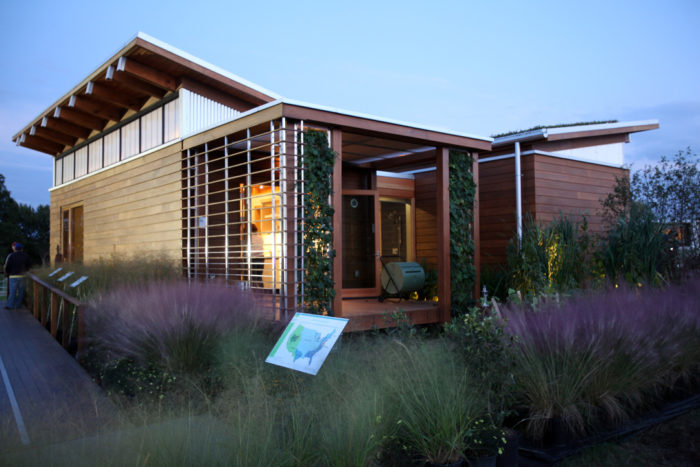
Image Credit: Department of Energy (images 2 - 4), Stefano Paltera/U.S. Department of Energy Solar Decathlon (images 1 and 5)
Image Credit: Department of Energy (images 2 - 4), Stefano Paltera/U.S. Department of Energy Solar Decathlon (images 1 and 5) Scoring in the solar village. Solar Decathlon standings on October 1, when the results of the market appeal contest, won by Middlebury College’s Self-Reliance house, and the Decathlon’s overall winner, University of Maryland’s WaterShed house, were announced.
Image Credit: Department of Energy (images 2 - 4), Stefano Paltera/U.S. Department of Energy Solar Decathlon (images 1 and 5) University of Maryland’s WaterShed house dominated the top spots in the Solar Decathlon rankings as the week progressed.
Image Credit: Department of Energy (images 2 - 4), Stefano Paltera/U.S. Department of Energy Solar Decathlon (images 1 and 5) Over the course of the competition, the 19 Solar Decathlon entries collectively produced more energy than they consumed from the grid.
Image Credit: Department of Energy (images 2 - 4), Stefano Paltera/U.S. Department of Energy Solar Decathlon (images 1 and 5) Department of Energy Secretary Steven Chu spoke with Jeffrey Tiller, left, and David Lee, members of Appalachian State’s Solar Decathlon team, on September 30. Although the school’s entry, Solar Homestead, placed twelfth in the overall standings, it won the Solar Decathlon 2011 People’s Choice Award.
Image Credit: Department of Energy (images 2 - 4), Stefano Paltera/U.S. Department of Energy Solar Decathlon (images 1 and 5)
The second time was the charm for University of Maryland. The school took second place in Solar Decathlon 2007 and parlayed its experience into a very solid first-place finish in the 2011 edition, which wound down on Sunday in Washington, D.C.’s West Potomac Park after almost two weeks of site preparation and installation work, visitors, and evaluations in the competition’s 10 contest categories.
Yes, the 19 schools competing in Solar Decathlon 2011 endured more than their fair share of overcast skies and rain, but the solar houses still performed as designed and the students somehow sustained the high level of energy required to install and present their entries. By Saturday, October 1, however, with all of the contest jurying and measuring completed, Secretary of Energy Steven Chu announced that Maryland’s entry, a 920-sq.-ft. double-module home called WaterShed, had won the competition. Purdue University’s 984-sq.-ft. INhome, which features a traditional suburban look, took second, and Team New Zealand, representing Victoria University of Wellington, took third with its 813-sq.-ft. “Kiwi bach”-inspired First Light.
Scoring highlights
In fact, WaterShed had been dominating the No. 1 spot in the rankings all week, scoring 90 or more points out of 100 in eight of the Decathlon’s 10 competition categories: architecture (in which WaterShed scored 96.0 points), market appeal (94), engineering (89), communications (88), affordability (91.336), comfort zone (96.139), hot water (100), appliances (99.798), home entertainment (97.847), and energy balance (100).
The rankings for the market appeal contest (a juried category gauging marketability and livability) also were announced on Saturday, with the category winner, Middlebury College’s Self-Reliance house, earning 95 points.
Beyond the prestige of scoring high in a juried and measured contest, though, is being the visitor favorite, which the Decathlon, to its credit, recognizes with the Solar Decathlon 2011 People’s Choice Award, won by the team representing Appalachian State University and its Solar Homestead, a two-bedroom home of almost 1,000 sq. ft. that offers an architectural nod to the pioneer era in Appalachia. The house placed twelfth in the overall rankings, but, as a Decathlon contest official noted, the home’s modular design and overall comfort, and the team’s contagious enthusiasm attracted the winning share of the 92,538 popular votes cast.
Weekly Newsletter
Get building science and energy efficiency advice, plus special offers, in your inbox.















0 Comments
Log in or create an account to post a comment.
Sign up Log in